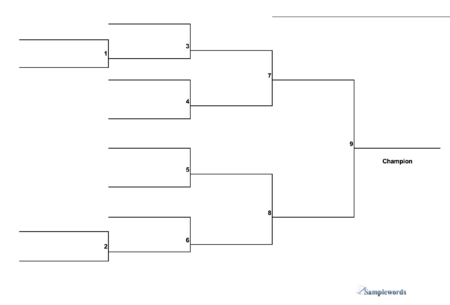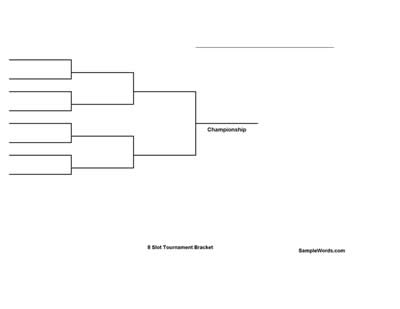The Free Printable Tournament Bracket provides an empty tournament bracket for ten teams under the single elimination format.
You can use this spreadsheet to track any simple 10-team tournament.
How does the 10 Team Tournament Bracket work?
Multi-team competitions via a bracket is a type of tournament format used in many sports, including basketball, baseball, softball, and volleyball. This form is used for a 10 team single-elimination tournament, meaning that once a team loses a game, they are eliminated from the tournament. A bracket including ten teams will normally have only four teams competing in the first round for positions in the main bracket. The following three rounds will play out the same as an 8-team tournament bracket. Games are numbered in the bracket for the order of play. For instance, two teams will compete in Game 1 and the winner will move on to Game 3. Any games in the same round can be completed concurrently or out of order as long as all games in a round are complete before the beginning of the following tournament round.
If your tournament is using a pool play format to populate your bracket we have explained this toward the bottom of this page.
Download 10 Team Single Elimination Bracket

10 Team Single Elimination Tournament Bracket
How to set up a 10 Team Tournament Bracket
Setting up a ten-team tournament bracket is fairly straightforward. Here’s how you can do it:
- For your single-elimination format: A single elimination setup is the simplest and most common format. In this format, each team will play against a single opponent in each round. The losing team is eliminated from the tournament, while the winning team advances to the next round.
- Set up the bracket: Draw the teams for the tournament in a logical way that matches the four lowest-seeded teams in the first round. A ten-team bracket can be set up in several different ways, but a common format is to have the first round consist of two games, with the winners of each game advancing to the second round.
- If you don’t have pool play or records from which to seed your teams then you can randomize the matchups: Assign each team a number from 1-10 and randomize the matchups for the first round. For example, match up teams 1 and 2, 3 and 4, to advance and play teams 5 and 10 respectively. Then, 7 and 8, and then 9 and 10 will also play in the second round.
- Assign the winners: The winners of each game will advance to the next round. If there is an odd number of teams (if someone drops out and causes a change to a 9-team format), one team will receive a bye (in effect win by forfeit) in the first round and automatically advance to the second round.
- Continue the tournament: Continue the tournament in this manner, with the number of games decreasing in each round as teams are eliminated. The semifinal will consist of two games. The two winners of the semifinal games will advance to the championship. The final game will determine the tournament champion.
- Determine the third-place finisher: To determine the 3rd place team, you may hold a third-place game between the two losing teams from the semifinals. Alternatively, you can rank the 3rd place team based on score differential between the two semifinal games.
By following these steps, you can set up a ten-team tournament bracket using a single-elimination format. It is important to make sure that all participants understand the rules and format of the tournament in order to ensure a fair and enjoyable competition.
Pool Play Tournament Seeding Formats
Setting up a pool play format for a tournament bracket involves the following steps:
- Divide the teams into groups, or pools of five teams each. We will end up with two pools. If a team should drop out (leaving nine teams) we recommend dividing into three pools of three teams.
- Determine the format for the pool play. One common format is round-robin, where each team in the pool plays every other team in the pool once. Alternatively, you can limit the number of pool games to three if needed.
- Determine the seeding for the tournament bracket based on the results of the pool play. For example, the top seed could be the team with the best record in the pool play, followed by the second-best record, and so on. In most competitions the first ranking factor is a team’s win/loss record. Since pool participants often tie with another team we use a run or score differential to break the ties. A run or score differential in baseball or softball for instance would be runs earned versus runs surrendered. A loss of 8-6 would yield a -2 score differential where the winning team would earn a +2.
- Create the tournament bracket based on the seeding. Once you have determined the rank of participants from each pool, populate the tournament bracket accordingly.
- Play the tournament bracket, with the winners advancing to the next round until a champion is crowned.
Overall, the key to setting up a pool play format for a tournament bracket is to determine the number of teams, the format for the pool play, the number of teams that will advance, and the seeding for the tournament bracket.
Matches between the bottom four seeded teams are usually the first round for a 10-team tournament. Then those winners advance to the more familiar 8-team layout.






